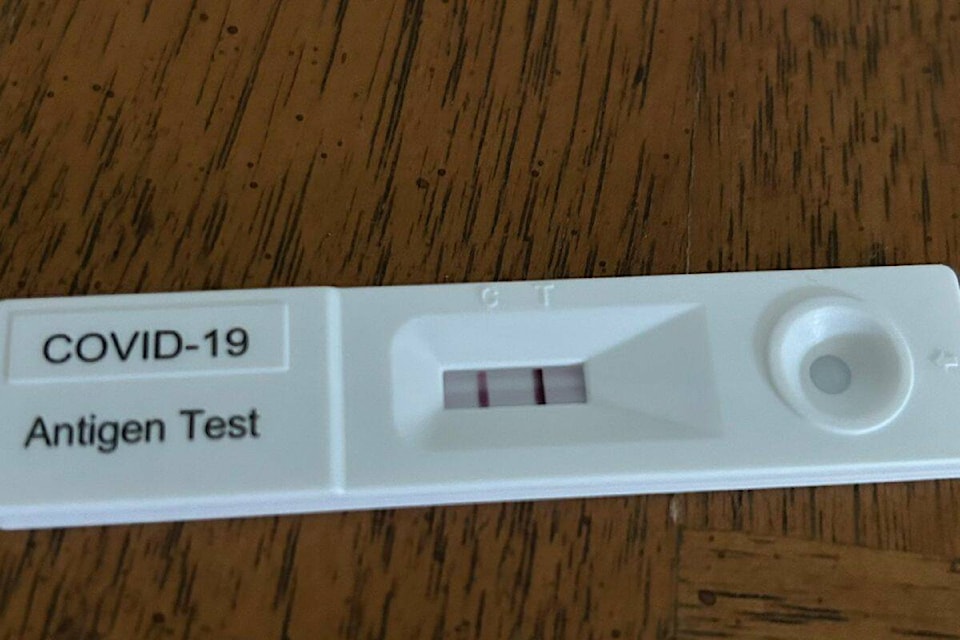Two lines show up within seconds of dropping the four droplets on the test device.
This means I have COVID-19.
I am devastated, as this is my first time getting it. While I did not need medical attention, I had almost every symptom the British Columbia Centre for Disease Control (BCCDC) listed.
What surprised me, though, was that I did not test positive until day three of symptoms, and that was when I was finally starting to turn a corner.
I cancelled a planned trip home for later that week and called in sick to work.
During the pandemic, I became a tad obsessed with learning as much as I could about COVID.
I watched every press conference by the B.C. Ministry of Health and read as much as I could on the virus. I am by no means an expert, just a curious citizen (it is important to note that I was not yet a journalist).
I knew that it was important to keep testing when I had symptoms, even if the test was negative. But how long should you test, and when do you stop and settle on it being another virus or cold?
Let’s talk to the experts.
In an emailed statement to the Now-Leader, the BCCDC answered my questions. All of this information can also be found on its website.
RAPID TESTS
Rapid antigen tests, commonly known as rapid tests, are used to see if a person has COVID-19, but according to the BCCDC, when you test matters. The BCCDC recommends people only use the rapid test when they have COVID-19 symptoms.
“If a person with COVID-19 tests too soon after they become infected, the test result can incorrectly show as negative; this is called a false negative,” states the BCCDC. It can take three to seven days post-infection to show a positive test result.
If the test is negative, the BCCDC recommends those eligible for treatment should repeat the test in 24 hours if they still feel sick or their symptoms worsen.
“You may repeat the test every day for five days as long as you feel you are not improving. If the test remains negative by day five of your illness, it is unlikely you have COVID-19,” the BCCDC says. “A COVID-19 test is recommended when a positive or negative result will inform decisions about treatment or care.”
Testing is especially recommended for people with COVID-19 symptoms who are at risk of more severe disease, hospitalized or pregnant.
The BCCDC also notes a negative rapid antigen test (after testing positive) is not needed for proof that it is safe to go back to daily activities.
Rapid tests are available for free at most community pharmacies.
ISOLATING WHEN SICK
Fourteen days, 10 days, five days, three days. How many days are you supposed to isolate when you are COVID-19 positive, and why do the numbers keep changing?
“The guidance for how long to isolate when sick has evolved over time based on the science showing that the majority of spread occurs early in the course of illness,” the BCCDC stated.
While there appears to be no exact number of days anymore, one thing remains true. If you have symptoms of respiratory illnesses like COVID-19, RSV and influenza, stay home if you can.
If you cannot avoid close contact with others, the BCCDC recommends preventative measures such as masking indoors and cleaning your hands regularly.
Those with symptoms are encouraged to stay home and avoid close contact with others until they no longer have a fever and feel well enough to return to their regular activities.
Once your fever is gone and symptoms have improved, you can see your friends and family again, although the BCCDC recommends wearing a mask and taking additional precautions if you visiting with someone who is at a higher risk of severe illness.
MANAGING YOUR SYMPTOMS
Drink lots of water and fluids, rest and use a humidifier or hot shower to help ease a cough or sore throat. If you have a fever, non-prescription medicine like acetaminophen (Tylenol ®) or ibuprofen (Advil ®) can help with some of the symptoms.
If you cannot manage your symptoms at home, seek medical care.
If you have any questions, call 811 to talk to a nurse at HealthLink BC. This service is available in 130 languages.
If your symptoms worsen, or if they do not improve after five or six days, call 811, your family doctor or go to an Urgent and Primary Care Centre (UPCC).
And finally, go to an emergency department or call 911 if you:
• Find it hard to breathe
• Have chest pain
• Can’t drink anything
• Feel very sick
• Feel confused
More information on at-home testing, self-isolation, treatment and prevention can be found at the bccdc.ca or by looking at the BCCDC’s ‘personal toolkit for cold and flu season’.
Anna Burns is a Now-Leader staff writer. Email her at anna.burns@surreynowleader.com
